For the owners of 2022 Tucson with the 2.5 engine that have had fuel injectors gone bad, at how many miles did the issues start?
I'm wondering if the continued use of Techron Fuel Treatment and using top tier gasoline would keep the injectors running issue free.
I know about the TSB Hyundai has released about replacing injectors one by one under warranty but like all TSB, it may not affect every Tucson made in 2022 or above.
I'm wondering if the continued use of Techron Fuel Treatment and using top tier gasoline would keep the injectors running issue free.
I know about the TSB Hyundai has released about replacing injectors one by one under warranty but like all TSB, it may not affect every Tucson made in 2022 or above.






